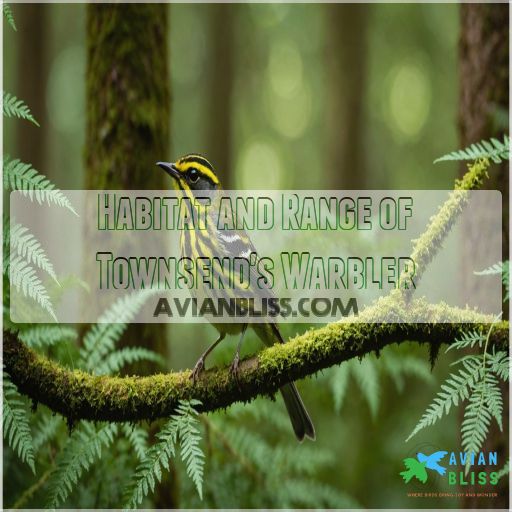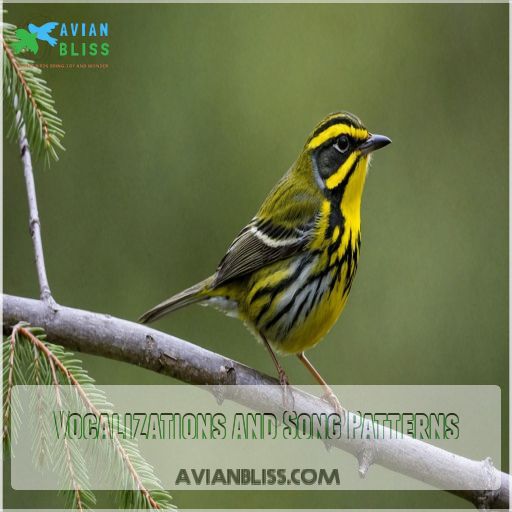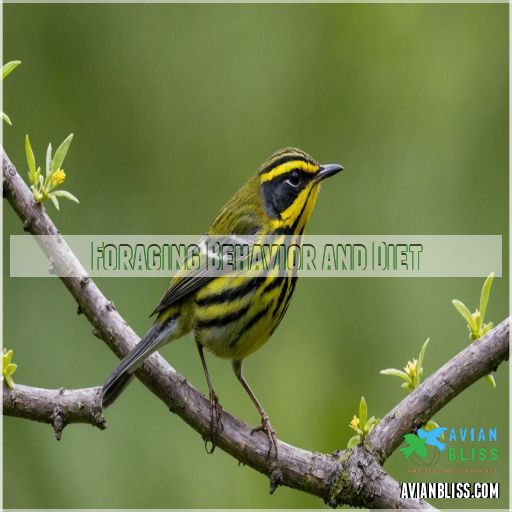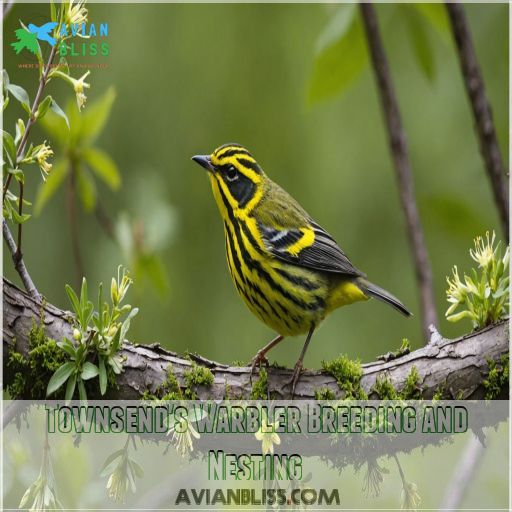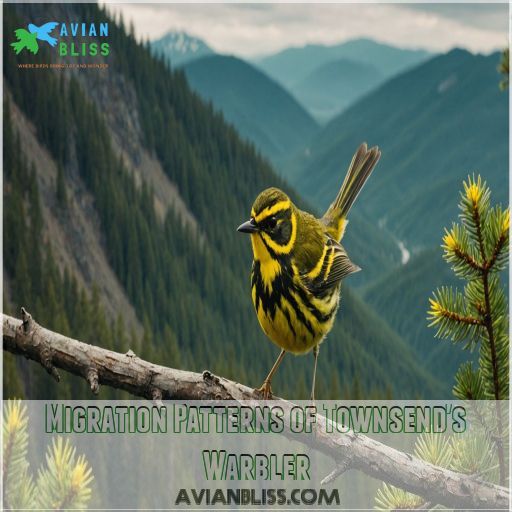This site is supported by our readers. We may earn a commission, at no cost to you, if you purchase through links.
 Meet the Townsend’s Warbler, a vibrant little daredevil flitting through the Pacific Northwest’s towering conifers. With its black throat and striking yellow patches, this avian jewel stands out like a ray of sunshine peeking through the forest canopy.
Meet the Townsend’s Warbler, a vibrant little daredevil flitting through the Pacific Northwest’s towering conifers. With its black throat and striking yellow patches, this avian jewel stands out like a ray of sunshine peeking through the forest canopy.
Males flaunt colors bolder than a peacock in a paint store. As you listen to its buzzy songs and melodic trills, consider its seasonal journey—breeding up north and wintering in Central America.
It’s a small bird with big adventures! Curious about how it survives and thrives? There’s so much more to the Townsend’s Warbler tale that’ll quench your adventurous spirit.
This avian jewel has a story to tell, and the Townsend’s Warbler is ready to surprise and delight with its remarkable journey. With its buzzy songs and melodic trills, it’s a sound that will leave you in awe.
Table Of Contents
- Key Takeaways
- Townsend’s Warbler: Identification and Appearance
- Habitat and Range of Townsend’s Warbler
- Vocalizations and Song Patterns
- Foraging Behavior and Diet
- Townsend’s Warbler Breeding and Nesting
- Migration Patterns of Townsend’s Warbler
- Conservation Status and Threats
- Frequently Asked Questions (FAQs)
- What are some fun facts about Townsend’s warbler?
- What looks like a Townsend’s warbler?
- Who is the Townsend’s warbler named after?
- How big is a Townsend’s warbler?
- What is the lifespan of Townsends Warbler?
- Do Townsends Warblers visit backyard feeders?
- How to distinguish Townsends from other warblers?
- What time of year are Townsends most active?
- Are Townsends Warblers susceptible to any diseases?
- Conclusion
Key Takeaways
- Get ready for some feathered flair. Townsend’s Warbler is a standout among North America’s birds with its striking black and yellow plumage. You’re not just birdwatching; you’re witnessing nature’s fashion runway.
- These little daredevils don’t just hang around. Each year, Townsend’s Warblers tackle epic migrations, breeding in the Pacific Northwest before vacationing in Central America’s tropical splendor. If only our commutes were half as exciting.
- Males sing buzzy, melodious songs that echo through the forests, making the treetops their concert hall. It’s like having a personal symphony in the wilderness—who needs Spotify when you’ve got nature.
- Despite their colorful charm, these warblers face threats from habitat loss and climate change, but don’t worry—conservation efforts are in full swing to keep their tunes playing strong. It’s a reminder that even the smallest creatures need a helping hand.
Townsend’s Warbler: Identification and Appearance
You’re about to discover the secrets of one of North America’s most striking warblers.
Get ready to learn how to spot a Townsend’s Warbler and tell it apart from its look-alikes as we unpack this forest gem’s unique features.
Distinctive Plumage Features
You’ll be dazzled by the Townsend’s Warbler’s eye-catching plumage.
This forest gem sports a striking black throat and vibrant yellow patches that’ll make your heart sing.
Look for its distinctive wing-bars and tail pattern, which set it apart from other warblers.
Males and females have slightly different looks, with the boys showing off bolder colors, it’s like nature’s own fashion show in the Pacific Northwest!
Size and Body Structure
While you’re marveling at the Townsend’s Warbler’s striking plumage, don’t overlook its compact yet agile build.
This feathered gem measures about 12 cm in total length, with a body mass of roughly 9 g.
Its size is perfectly suited for moving through dense coniferous forests.
The warbler’s streamlined body, coupled with its distinctive feather patterns, allows it to flit effortlessly through the canopy, a true master of its Rocky Mountain domain.
Comparison to Similar Species
Among warblers, Townsend’s stands out with its striking black-and-yellow pattern.
You’ll need a keen eye to distinguish it from its close cousins, especially the Hermit Warbler.
The key? Look for that distinctive black ear patch surrounded by yellow . Unlike the Black-throated Gray Warbler, Townsend’s sports a vibrant yellow face.
When in doubt, listen for its unique buzzy song – it’s a dead giveaway in the coniferous forests of British Columbia!
Seasonal Variations in Appearance
Just as you might change outfits for different seasons, Townsend’s Warblers undergo noticeable color changes throughout the year.
During their breeding season in British Columbia, molting patterns transform their plumage, revealing more striking colors.
Come winter, these warblers sport subtler hues, making their juvenile plumage a bit more subdued.
It’s interesting to note that these variations mirror the stable populations‘ adaptability to diverse environments .
Habitat and Range of Townsend’s Warbler
Explore the Townsend’s Warbler’s impressive journeys between the Pacific Northwest and Central America, and you might find yourself envious of their travel perks.
These vibrant songbirds prove they’re not just beautiful but also discerning, as they select only the finest forests to call home.
From coniferous trees up north to tropical wonders in winter, they select the best, which shows they’re discerning.
Breeding Grounds in Pacific Northwest
Once you grasp the Townsend’s Warbler’s distinctive features, learning their breeding grounds is a breeze.
These birds charm Pacific Northwest forests, showcasing territorial defense among conifers like Douglas fir and Engelmann spruce, sharing habitats with common songbirds of the Pacific Northwest
. High canopy nest site selection boosts breeding success rates.
Yet, future harmony might be affected as these habitats could be altered due to changes, affecting population density.
Winter Migration to Central America
While Townsend’s Warblers enjoy the Pacific Northwest’s lush summer, they head off on a grand winter adventure to Central America’s highlands.
You can picture them as tiny tourists in a vivid leafy paradise, finding their way to stopover sites with impeccable timing.
Although their wintering habitat brims with life, these warblers face threats like habitat loss, making conservation efforts absolutely essential.
Preferred Forest Types
Imagine stepping into a lush, old-growth forest with towering conifers—this is where the Townsend’s Warbler feels at home.
These songbirds thrive in unharvested, mature forests, leaning towards mixed coniferous and spruce-dominated stands.
Forest management that preserves these habitats is essential, as logging and climate change pose threats to their ideal living arrangements, requiring careful balancing of nature’s needs (Source).
Geographical Distribution
You’ll find Townsend’s Warblers darting through the coniferous forests of the Pacific Northwest during breeding season, a region that contrasts with the Blue-winged Warbler’s favored shrubby undergrowth and open woodlands.
These charming songbirds migrate south to Mexico and Central America for winter, though some stick around the U.S. Pacific Coast, a journey that requires flexibility in adapting to altered landscapes, similar to the Blue-winged Warbler’s ability to thrive in changing environments.
Their migration routes bring them through diverse habitats, highlighting the importance of conservation efforts to support their varied habitat needs
.
Vocalizations and Song Patterns
When you’re in the Pacific Northwest, keep an ear out for the Townsend’s warbler’s enchanting songs—they’re nature’s way of saying, "Hey, I’m here!"
These little songbirds have a unique way of turning their melodious tunes into operatic performances, complete with rising notes and charming "chip" calls.
Characteristic Song Description
The ethereal, buzzy songs of Townsend’s Warblers are a delight to the senses.
Their complex repertoire includes:
- Melodic trills and whistles that drift through the treetops
- Rapid, staccato bursts that seem to dance on the breeze
- Soulful, dawn-like choruses that herald the start of the day
- Regional variations that add to the species’ impressive vocal diversity
- Plastic, improvised songs that showcase their impressive vocal abilities
Call Notes and Chips
You’re fascinated by Townsend’s Warbler’s call notes, right? Their soft chip sounds like nature’s subtle percussion, hinting at nearby presence through forests. With a melody reminiscent of their eastern cousin, the Black-throated Green Warbler, these chips vary intriguingly in frequency.
| Sound Type | Tone | Function |
|---|---|---|
| Chip Note | Soft | Communication, species ID |
| Song | Buzzy | Vocal mimicry, attraction |
| Frequency | Variable | Song evolution |
Explore these soundscapes!
Seasonal Singing Behavior
After discussing their varied calls, let’s have some fun with Townsend’s Warbler’s seasonal singing.
During breeding season, males belt out a raspy tune to mark territory and woo mates—a real drama fest.
But come winter, they become surprisingly mute, focusing on staying cozy and fed.
Migration triggers brief melodies, hinting at adventures.
Regional Variations in Songs
Have you ever wondered how geography shapes sound, even in birds?
Townsend’s Warbler exhibits fascinating song dialects driven by geographic influences. These melodic variations, influenced by evolutionary pressures, serve acoustic isolation functions.
Human impact, however, can disrupt these patterns. It’s like listening to regional accents—warblers remind us that nature’s playlist is rich and varied.
Foraging Behavior and Diet
You’ll be amazed at the Townsend’s Warbler’s resourceful diet as it feasts on insects, nectar, and berries.
Imagine this tiny bird deftly fluttering among tree branches, teaming up with mixed flocks to find its next meal—proof that even nature’s smallest creatures can teach us a thing or two about teamwork and survival.
Insectivorous Feeding Habits
Up in the treetops, Townsend’s Warblers showcase their impressive insect-hunting skills.
These nimble foragers pluck caterpillars, beetles, and other tasty morsels straight from the conifer needles and bark.
Their quick reflexes allow them to even snatch flying insects right out of the air, showcasing their incredible aerial agility.
Nectar and Berry Consumption
Ever wondered about Townsend’s Warbler’s sweet tooth? These birds don’t just munch on insects—they also sip nectar and nibble on berries during winter.
- Nectar sources: Blooms along their migration route.
- Berry preferences: Especially fond of berries in tropical wintering grounds.
- Honeydew role: In some oak habitats, they enjoy honeydew secreted by scale insects.
Fun, right? Indulge their seasonal cravings!
Foraging Techniques in Trees
Imagine a tiny warbler deftly maneuvering through the tree canopy, expertly extracting insects from conifer needles with acrobatic ease.
Townsend’s Warblers excel at canopy foraging, employing hovering techniques and branch searches to outcompete others for food, even snatching insects mid-air.
Their life in the treetops involves diverse tactics and a keen eye for opportunity and employing acrobatic ease.
Mixed Flock Associations
You might be surprised by Townsend’s Warbler’s mixed flock foraging strategies. These social birds love group interactions, reaping benefits from diverse species composition.
- More eyes for spotting predators.
- Access to varied food sources.
- Improved foraging efficiency in trees.
- Learning new ecological interactions.
Their seasonal changes in associates bring interesting camaraderie!
Townsend’s Warbler Breeding and Nesting
In the intricate world of Townsend’s Warbler breeding, you’ll discover how these feathered architects carefully select nesting sites.
They craft their homes from natural materials.
While patiently nurturing their eggs, they prepare their young to fledge swiftly, proving they’re tiny masters of efficiency and resourcefulness.
Nest Construction and Materials
Townsend’s Warblers build their nests high up in the branches of coniferous trees, weaving a sturdy cup from twigs, pine needles, grasses, and rootlets.
They may also incorporate soft materials like moose, horse, or deer hair, as well as moss and lichens, lining the interior with delicate feathers.
This intricate nest-building process takes the female around 10 days to complete.
Egg-laying and Incubation Period
After mastering nest construction, females lay a clutch of eggs, typically pale with spots.
She handles incubation while her mate provides meals, ensuring warmth and support.
These little eggs, nestled in their cozy spot, face the ticking clock of hatchling development. It’s like a tiny family drama, with suspense and snack deliveries, one twig at a time.
Fledgling Development
Growing fast like chatter in a busy park, fledglings rely on their parents’ constant care and nutritious insect diet.
Their tiny wings, flapping in practice for future adventures, hint at the freedom awaiting beyond the nest.
As survival instincts kick in, their playful antics reveal the wonders of early birdhood, enchanting our hearts like a well-loved song.
Nesting Site Selection
As young Townsend’s Warblers take flight, the choice of nesting site becomes a game of hide and seek in the forest.
Females smartly select tall white spruce branches, balancing nest height and predator avoidance, a behavior also seen in coniferous forest dwellers.
They weave cozy homes in dense spruce clusters, ensuring safety and ideal habitat preferences, while embracing the art of subtlety and survival.
Migration Patterns of Townsend’s Warbler
Have you ever wondered how a small bird like the Townsend’s Warbler manages its epic journey from North America to Central America each year?
Discover how these feathered travelers master the art of migration, knowing exactly when to leave and where to rest along the way!
Spring Migration Timing
You’ve explored the Townsend’s Warbler’s family life—now let’s talk spring break!
These vibrant warblers typically kick off their spring migration in late April, arriving at their northern breeding grounds around May 1st .
Adaptable to weather changes, they navigate migration routes with skill, stopping at prime sites along the way.
Fall Migration Routes
While Townsend’s Warblers take a more eastern route during fall migration compared to spring, the journey is no less impressive.
These intrepid songbirds follow mountain chains and avoid arid basins, using geographic features to guide their looped migration pattern .
With millions of observations to draw from, scientists are unraveling the secrets of this species’ remarkable travels and their intrepid nature.
Stopover Sites and Behavior
Townsend’s Warblers don’t just flap through fall migration willy-nilly. They carefully select stopover sites, optimizing fueling strategies and avoiding predators.
Imagine these vibrant birds huddled in quiet forests, resting and replenishing precious energy stores.
Surprisingly, traffic noise from nearby roads can skew migration timing and affect their resting behavior, potentially impacting their ability to reach wintering sites efficiently.
Wintering Grounds Ecology
In the wintering habitat of Townsend’s Warbler, these birds charm California and beyond.
You might spot them exploring:
- Mixed conifer and oak woodlands for varied diets.
- Coastal riparian zones, adapting to available resources.
- Group camaraderie in flocks to better evade threats and conserve energy.
Their clever strategies echo resilience and community.
Conservation Status and Threats
You might think Townsend’s Warbler has it all figured out,
but climate change and habitat loss are crashing its forest party.
Don’t worry, though—there are conservation champs ready to fight for this bird’s future, ensuring the songbird’s story doesn’t end on a sour note.
Population Trends and Estimates
After seeing the migration wonders, let’s chat about population trends. Townsend’s Warbler populations appear stable but remain under watch for habitat loss impacts. Breeding success and conservation efforts are in constant motion to help them survive.
| Aspect | Description |
|---|---|
| Population Dynamics | Generally stable |
| Habitat Loss Impact | Moderate concern |
| Breeding Success | Varies regionally |
| Conservation Efforts | Ongoing |
Monitoring efforts keep these vibrant songbirds in good stead.
Climate Change Impacts
How’s climate change affecting Townsend’s Warbler? These charming birds are under threat as warming alters their habitats.
Imagine their struggles:
- Shortened breeding windows, leaving less time for courtship and nesting.
- Disrupted food availability impacting their diet of insects and berries.
- Shifting migration patterns, making their journeys more perilous.
Our scientific insights aim to safeguard their future.
Habitat Loss Concerns
Townsend’s Warbler navigates a changing world where trees are disappearing faster than socks in a dryer. Their lofty conifer habitats are disappearing due to logging and development, threatening their existence.
They rely on vibrant forests for breeding and survival, facing off against habitat loss and climate change impacts .
| Issue | Impact |
|---|---|
| Habitat Loss | Reduced breeding sites |
| Logging | Fragmented forests |
| Development | Loss of wintering grounds |
Conservation Efforts and Strategies
You know, addressing habitat loss isn’t just about protecting trees.
It’s a lively endeavor in conservation! By embracing habitat restoration, supporting climate change strategies, and championing forest management, you actively help Townsend’s Warblers thrive.
Engaging in citizen science and advocating for protected areas also adds color to the effort, ensuring these vibrant songbirds linger in our midst.
Frequently Asked Questions (FAQs)
What are some fun facts about Townsend’s warbler?
The Townsend’s warbler, known for its dreamy, buzzy songs, thrives in diverse habitats from Mexico to the U.S. Pacific Coast.
These colorful birds love backyard feeders in winter, especially during cold spells.
What looks like a Townsend’s warbler?
Did you know that over 50 species of warblers can be found in North America?
While the Townsend’s warbler is a unique beauty, the Black-throated green warbler shares a similar striking appearance.
Who is the Townsend’s warbler named after?
Townsend’s Warbler is named after John Kirk Townsend, a 19th-century American ornithologist.
His controversial legacy has sparked debate over renaming.
How big is a Townsend’s warbler?
Ever wondered how small a vibrant bird can be?
Townsend’s warbler measures about 4 1/4 to 5 inches in length, or roughly the size of a sparrow, showcasing its striking yellow, black, and green plumage.
What is the lifespan of Townsends Warbler?
You’d be hard-pressed to find detailed lifespan data for Townsend’s Warbler, but many similar warbler species generally live around 3 years.
These tiny travelers face various challenges that can affect their longevity.
Do Townsends Warblers visit backyard feeders?
While backyard birds of Wisconsin feeder visits from this charming bird are rare
,
you can entice it with a suet feeder.
Townie’s warblers have a taste for suet, providing a delightful feast for any lucky birder.
How to distinguish Townsends from other warblers?
Spot Townsend’s Warblers by their striking yellow faces with dark cheeks and green backs.
Males flaunt black throats, while females and juveniles show more yellow.
Listen for their distinctive buzzy songs amid coniferous forests.
What time of year are Townsends most active?
During spring and fall, Townsend’s warblers are most abuzz with energy.
They showcase their fleeting grace as they migrate.
North in spring along the Pacific Coast, south in fall through the Rockies (Source).
Are Townsends Warblers susceptible to any diseases?
Townsend’s Warblers can be susceptible to arboviruses like West Nile Virus, as some studies have tested other warbler species for exposure to such diseases.
However, direct studies on Townsend’s Warbler regarding diseases are limited (Source).
Conclusion
Talking about the Townsend’s Warbler, the phrase "small but mighty" fits like a glove. You’ve uncovered its secrets—from vibrant plumage to spirited melodies and intrepid migrations.
Whether nesting in the Pacific Northwest or wintering in Central America, this avian marvel thrives amid challenges.
Its journey reminds us of nature’s resilience and beauty. So, next time you’re in a coniferous forest, listen closely; you might just hear the Townsend’s Warbler sing its remarkable story.


